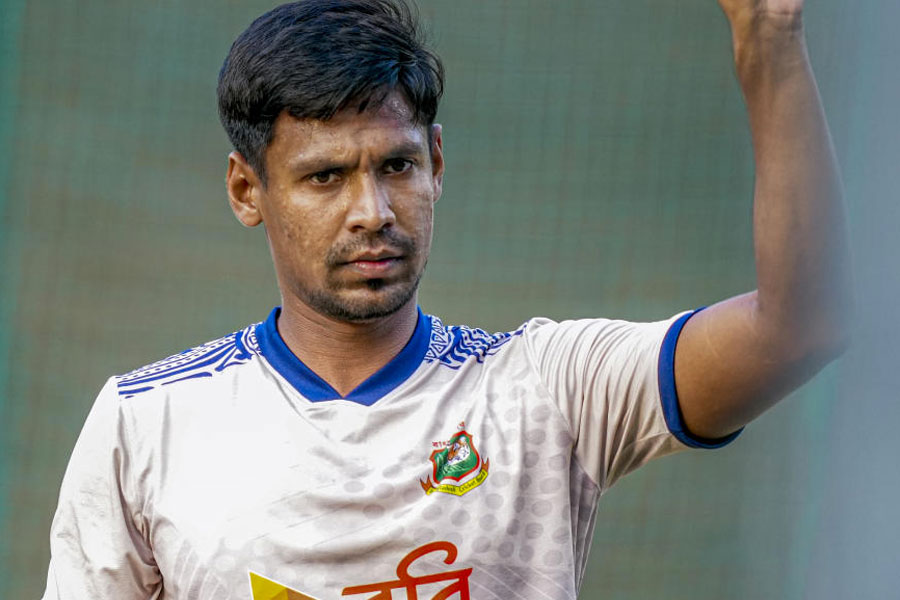-

JAPANESE WAVE: A boy dressed as Hidan from the anime series Naruto at the Nagaland Anime Cosfest
The summer vacations were a holiday to remember, says Akumtong Jamir. The high school student from Kohima didn't step out of the house even once during the two months. He stayed at home and watched anime — animated Japanese cartoon strips — through the day. 'I am happy in my online world,' he says.
In many parts of Nagaland, Jamir's action will not raise eyebrows — at least not among the youth. On the contrary, most young men and women in the state would share his passion.
A small group of youngsters huddled together on the streets of Dimapur on a Sunday afternoon is a case in point. They are speaking in English, but words such as shimatta, matte and mite pepper their language. These are Japanese words for 'damn', 'wait' and 'look', respectively. Speaking a few words of Japanese is essential when friends meet, high school student Grace Saprii stresses.
Khyopeni Patton, a student of the Dimapur Government College, is another fan of all things Japanese. In an oversized red shirt paired with a black spaghetti top and leggings, eyes coated with a thick black liner and lips a shade of hot pink, she could be a character in an anime strip. 'Every weekend we meet to discuss anime episodes we have watched over the week,' she says.
In the heart of Nagaland, a Japanese sub-culture is taking root. A few years ago, it was a Korean wave that had swept across the northeastern state — with the spread of Korean music, television series and even hairstyles. But Korea hallyu (wave) has now been dislodged by a Japanese tide. Now, it's the time for anime and manga (Japanese comics).
And within Japanese lovers, too, there are categories. Otakus are Japanese geeks. Wapanese are the wannabe Japanese, who follow the fashion trends of Japanese movie stars. The Otakus are identified by their graphic tees and often sport spiky hairstyles. 'I need no friends other than fellow Otakus,' says Jamir.
The trend is fairly new, but is spreading. 'A trend of aestheticism that leans towards Japanese culture appears to be emerging,' says Al Nguille, a youth commentator from Dimapur.
So it's not surprising that Jumping Bean, a popular youth hangout in Dimapur, has an exclusive section that sells manga, anime and Japanese films. Manager Yanger Aier says the café has seen the demand for manga and anime grow by 30-50 per cent every year since it was started in 2008. 'Our clientele extends from pre-teens to 25-year-olds,' Aier stresses.
Anime, depicting vibrant characters in action-filled plots often with futuristic themes, isn't a new phenomenon in India. But for youngsters in the northeastern states, the genre is an all-consuming passion. It's become so popular that festivals are being held. In July, the Nagaland Anime Cosfest competition was held in Kohima where over 500 youngsters from Nagaland, Manipur and Arunachal Pradesh came dressed as their favourite anime characters. The event was organised by the Nagaland Anime Junkies, a Facebook group formed in 2011 by Kohima's anime lovers.
'It was a huge success and will now be an annual event. We are now flooded with requests to have a similar show in Dimapur,' organiser Biebe Shini Angami says. When the group was formed it had just a dozen-odd members. 'Today we have 4,000 fans, mostly from Nagaland,' Angami adds.
Anime clubs — which are popular in colleges and schools in Japan — are now cropping up here. Lyna Tep from Dimapur is a part of one such informal club. 'We dress up as our favourite anime characters, shoot pictures or videos, and send them to our friends,' she says.
-

Dimapur girls with their anime CDs and DVDs
How did the Japanese quietly invade Nagaland? It's been gradual, locals say. In 2002, a group of Japanese religious leaders visited Nagaland and apologised to the people for the Battle of Kohima — the Japanese invasion during World War II. In 2009, Japanese musicians performed in Kohima. In 2011, popular rock bands in Nagaland organised a solidarity fund-raising event for Japan's earthquake and tsunami victims. 'These were all events building up to our interest in Japan,' Nguille says.
The 2011 cult Japanese film Crows Zero — revolving around delinquents in a high school and based on a manga series — took the Japanese fad to the next level. Departmental stores set up exclusive manga and Japanese movie kiosks. Youngsters started wearing tees with 'Otaku' printed on them. 'There is a huge demand for merchandise and we are thinking of starting an online store,' Angami says.
Today it is not uncommon to come across a Naga youth who goes by a Japanese nickname. 'If you go through Nagaland-based profiles on the Internet, a majority of those in the pre-teen to 21-year group goes by Japanese names,' Nguille says.
Locals are still wondering why a Naga youth seeks to embrace Japanese culture. Some believe it's a question of identity. 'We are confused about our identity,' says Hitoika Chophi, a 24-year-old Nagaland University student. 'Our looks match more with Japanese looks than with those of mainstream Indians,' he adds. Like many of his peers, Chophi dreams of working in Japan after pursuing a course in animation.
'Japanese culture has started making its impact felt across the globe and eastern India is also not untouched,' says Yojiro Tanaka, director of Japanese Language and Studies, The Japan Foundation, Delhi. The not-for-profit organisation is seeking to tap this interest. 'We keep looking for opportunities wherein we can organise events especially in lesser reached areas such as the northeastern states,' Tanaka adds. It organised a Japanese film festival in Guwahati recently.
The youngsters stress that the Japanese fad is more to their liking than the Korean trend that was at its peak three years ago. Korean serials, they point out, were family dramas that didn't always excite the young. 'Anime is action-packed, youth-centric, with more violence and less romance,' Tep says.
'The Korean flavour is on a decline,' agrees Theja Meru, a cultural promoter and entrepreneur. 'At present, the Japanese wave is an underground sub-culture. People of my generation are still not fully aware of its existence,' the 43-year-old musician says.
Of course, not everybody is happy with the trend. The popularity of Crows Zero had led to the formation of school gangs across the state. When some of the gangs indulged in violence, the government banned the sale of DVDs and CDs of the film.
Parents also complain that many Otakus spend sleepless nights watching anime online or playing video games related to these characters for five to six hours at a stretch.
The fad, however, hasn't made a serious dent on Nagaland's business relations with Japan yet. But Nagaland is looking at Japan for investments. 'Japan wants to invest in rearing silkworms here. Japanese officials are going to visit Nagaland later this year,' says Pukhayi Sumi, parliamentary secretary of sericulture, co-operation and women development.
'It's just another fad,' says Himato Zhimomi, commissioner and secretary for tourism, art and culture. 'I think minor cultures such as ours will always be swayed by waves of influences from other cultures. It's a normal phenomenon,' Zhimomi stresses.
An Otaku would bow to that. And possibly turn the fad into an anime to watch out for.
What's happening?
Japanese animation, comics, films and music are the rage in Nagaland.
What has it led to?
School gangs, anime and Otaku clubs.
What are Otakus?
Japanese geeks. Other followers are called Wapanese, or wannabe Japanese.
What else?
Nagaland's young are adopting Japanese nicknames.











